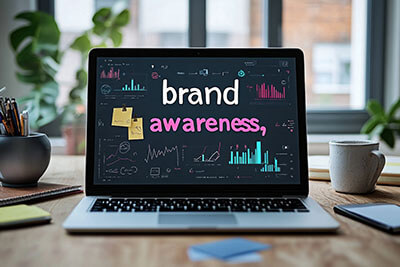One of the main goals of any business is continued growth. For those struggling to achieve it, full-funnel marketing is a proven strategy that delivers on multiple fronts—from building awareness to driving conversions and retaining customers. Unlike siloed campaigns, which often address only specific stages of the buyer’s journey, full-funnel marketing ensures your brand engages with potential customers at every phase of their decision-making process.
It’s about meeting your audience where they are, whether they’re discovering your brand for the first time or evaluating products before making a purchase. Let’s explore five of the most compelling benefits of a full-funnel marketing approach together to see how it can transform your business.
Parts of a Full-Funnel Strategy
To better understand the benefits, you must first know the basics of the full-funnel approach. This strategy divides into three key phases:
- top of funnel (TOFU) – for attracting new leads,
- middle of funnel (MOFU) – for engaging and educating prospects, and
- bottom of funnel (BOFU) – for converting them into loyal customers.
Beyond conversions, full-funnel marketing also emphasizes retention, leveraging retention-focused tactics to build stronger, lasting relationships with existing customers.
The magic here is that each part works together to give you full control of the customer journey. While it’s obvious that this can be advantageous to any business, understanding the nuances of how these gears fit together is the real secret to capitalizing on the benefits of a full-funnel marketing strategy.
1. Increased Brand Awareness

One of the primary goals of top-of-funnel marketing is to generate greater brand awareness. However, not all brand awareness efforts are created equal. Rather than simply seeking a larger audience reach, full-funnel strategies aim to connect with the right audience. This starts with carefully defining your ideal buyer personas. Who are your customers? What are their pain points? Where do they spend their time online?
Social media platforms play a pivotal role in this phase, particularly through the use of video ads, influencer collaborations, and engaging content that introduces your brand in a memorable way. Utilizing paid social media services can help businesses cast wider nets than they could on their own while still remaining intentional about the types of users they reach.
With these strategies, businesses can not only build brand recognition but also ensure their message resonates with the right people. By focusing on authentic connections instead of vanity metrics like sheer impressions, businesses are better positioned to stay top-of-mind for their most relevant audiences.
2. Stronger Engagement in the Middle of the Funnel
After capturing attention at the top, sustaining engagement in the middle of the funnel becomes critical. The MOFU stage is where brands educate, nurture, and build trust with their audience. At this phase, potential customers have shown interest in your product or service, but they need more reassurance. They want to know, “Why you?”
While content is helpful in the early stages, MOFU is where it really shines. For example, product demos, customer testimonials, how-to guides, and comparison content can instill confidence in your offerings. Retargeting ads, reminding audiences of your brand or showcasing specific benefits, can strengthen their consideration. On top of that, carousel ads or infographics can highlight the versatility of your product, while case studies demonstrate real-world success.
By leveraging data-driven audience segmentation, you can fine-tune this approach further, ensuring you deliver personalized, engaging content that reflects your prospects’ unique preferences and concerns. This combination of trust-building and personalization ensures higher engagement and smoother transitions further down the funnel.
3. Higher Conversion Rates and Sales at the Bottom of the Funnel

The bottom of the funnel is where the magic happens. Your prospects are now well-informed and on the cusp of making a purchase decision. The emphasis shifts from education to action, often with the use of conversion-focused messaging and promotional strategies.
At this stage, businesses see success by leveraging dynamic product ads, urgency-driven promotions, and personalized offers. Prospects are more likely to convert when presented with time-sensitive discounts or engaging copy that highlights benefits relevant to them. Features like click-to-message ads and lead generation forms also simplify the process for users, helping remove potential friction.
Here, retargeting takes shape with tailored product ads aimed at recent shoppers, drawing on their past browsing behavior to spark renewed interest. This can be one of the most effective ways to drive more conversions and create loyal customers. Regardless of how you go about it, staying relevant and maintaining a sense of urgency will help you achieve your true growth potential.
4. Maximized Ad Efficiency and Lower Cost per Acquisition
Efficient marketing isn’t about spending big; it’s about spending smart. Full-funnel strategies are uniquely designed to maximize ROI by eliminating waste and leveraging data to refine efforts continuously.
Using AI-powered bidding strategies, businesses can optimize engagement throughout the funnel. For instance, your initial ads might focus on driving awareness at a low cost, while subsequent campaigns nurture warm leads over time. By targeting users with higher levels of intent in later stages, companies prevent wasted spend on audiences who aren’t ready to convert just yet.
Additionally, by focusing on nurturing leads who’ve already engaged with your brand, businesses naturally see a reduction in cost per acquisition (CPA). Warm leads tend to be more affordable to convert compared to starting from scratch with cold outreach campaigns. This approach ensures every dollar spent on ads has a greater impact, driving both short-term and long-term growth.
5. Improved Customer Lifetime Value and Retention

Most businesses know that the customer’s journey doesn’t end at the point of conversion, but not many of them do much to capitalize on this. Full-funnel marketing helps with this by extending beyond the initial sale, emphasizing post-purchase engagement and retention as key drivers of overall growth.
Loyalty campaigns, upselling strategies, and personalized follow-ups can keep your brand top-of-mind with existing customers. Social media engagement, email drip campaigns, and exclusive subscriber rewards are effective in fostering long-term relationships. Why? A loyal customer base not only provides repeat business but also serves as brand advocates who promote your offerings organically.
By integrating audience lists into paid social strategies or supplementing efforts with CRM email marketing integrations, businesses can engage customers with messages that feel personal and relevant. It’s also worth noting that improved retention doesn’t just increase customer lifetime value (CLV)—it also reduces reliance on new customer acquisition, providing a major competitive advantage.
6. Data-Driven Optimization and Better Decision-Making
A major advantage of full-funnel marketing lies in its ability to provide valuable, data-driven insights. Analyzing performance across every stage of the funnel allows businesses to identify what’s working (and what needs improvement), resulting in smarter decision-making over time.
Cross-platform tracking provides an invaluable view of how customers interact with your brand at different touchpoints. For example, multi-touch attribution helps reveal which channels and efforts are truly driving conversions. Similarly, running A/B tests at each stage of the funnel leads to continuous improvement.
Whether you’re testing ad creatives at the top, retargeting campaigns in the middle, or conversion pathways at the bottom, optimization ensures that your marketing remains agile and effective. By committing to an iterative, data-driven approach, companies can future-proof their strategies and make confident decisions aligned with their goals.





